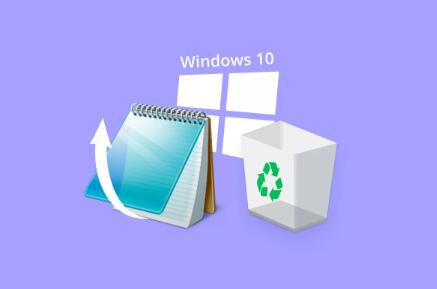In the vast landscape of digital tools, Notepad remains one of the simplest yet most useful applications for jotting down quick notes, drafting code, creating logs, or editing plain text. However, because Notepad lacks features like autosave or version history (especially in older versions), it can be devastating when you close a file without saving or your computer crashes unexpectedly.
1. Why Notepad Doesn’t Autosave
Unlike Microsoft Word or Google Docs, Notepad is a plain text editor with very few features intentionally so. It doesn’t autosave or offer a document recovery prompt upon restarting. This means:
If you close Notepad without saving, the content is immediately lost.
If your system crashes, the open Notepad window’s data may be wiped from memory.

No drafts or backup copies are made unless you use third-party enhancements.
However, some Windows features and file traces may help recover your data under certain circumstances.
2. First Things First: What to Do Immediately After Loss
If you’ve lost an unsaved Notepad file:
Don’t restart your computer. Unsaved temp files stored in RAM or swap might still be accessible.
Avoid writing or saving new files. This could overwrite areas of disk space where the lost file may still reside.
Take note of where the file was being worked on (Desktop, Documents, etc.).
Try to remember if you saved it even once this widens your recovery options.
3. Method 1: Check for Temporary Files
While Notepad doesn’t autosave, Windows may create temporary files during your session. These files may remain behind after crashes.
Steps to Locate Temporary Files:
Press Windows + R to open the Run dialog.
Type:
shell
CopyEdit
%AppData%\Microsoft\Windows\Recent\
Press Enter.
If the file was ever saved temporarily, you might see it listed here.
Alternatively:
Open File Explorer.
Navigate to:
mathematica
CopyEdit
C:\Users\[YourUsername]\AppData\Local\Temp
Look for files like ~WRLxxxx.tmp, Untitled.txt, or files created at the time of your loss.
Open them in Notepad to check for your content.
Note: Temp files often don’t have descriptive names, so you’ll need to browse by date modified.
4. Method 2: Check the Unsaved File Folder (Windows 10/11)
In newer versions of Windows and Notepad, some features allow minimal recovery under specific circumstances—particularly if the new Notepad app crashed unexpectedly.
Steps:
Open File Explorer.
Navigate to:
mathematica
CopyEdit
C:\Users\[YourUsername]\AppData\Local\Packages\Microsoft.WindowsNotepad_8wekyb3d8bbwe\LocalState
Look for files such as:
Recovery.txt
Unsaved.txt
Files without extensions
Open these files using Notepad or WordPad.
This location is where modern Notepad (Windows Store version) may store crash-recovery versions.
5. Method 3: Recover from Recent Files
If you had saved the file at least once, even in a different version or name, you might still find it in the Recent Items list.
Try This:
Open Notepad.
Press Ctrl + O or go to File > Open.
Click This PC or Documents.
Check the Recent Files list on the left panel.
Also, check the Recent folder manually:
mathematica
CopyEdit
C:\Users\[YourUsername]\AppData\Roaming\Microsoft\Windows\Recent
Files here may have pointers to previously opened files—especially helpful if you forgot the file name.
6. Method 4: Use the Search Function to Find Hidden Files
Use Windows Search to locate any .txt file on your system.
Steps:
Open File Explorer.
In the search bar, type:
CopyEdit
*.txt
Use filters such as Date modified: Today or This week.
Browse the results for your lost content.
You may find a version saved to a different location or as a copy you weren’t aware of.
7. Method 5: Restore from Backup (File History or OneDrive)
If you have File History or a cloud backup enabled, your saved Notepad files may still be recoverable.
File History (Windows Backup):
Navigate to the folder where your file was saved.
Right-click anywhere in the folder.
Choose Properties > Previous Versions.
Select a version before the file was lost and click Restore.
OneDrive:
Go to onedrive.live.com.
Check your Documents, Desktop, and Recycle Bin folders.
Download any version of the file you find.
Cloud backups are incredibly helpful for accidental deletions.
8. Method 6: Check the Recycle Bin
If your file was deleted manually, but not yet emptied from the Recycle Bin:
Open the Recycle Bin.
Search or sort by Date Deleted.
Locate your .txt file.
Right-click > Restore.
This will place the file back in its original folder.
9. Method 7: Use a File Recovery Tool Like Panda Assistant
If the above methods don’t work—especially when a file was never saved—then your best chance lies in using a file recovery tool.
What is Panda Assistant?
Panda Assistant is a user-friendly data recovery software designed to restore lost, deleted, or unsaved files on Windows and macOS.
Key Features:
Recovers .txt and .log files even if unsaved.
Deep scans unallocated space for remnants of lost files.
Recovers files from formatted, damaged, or corrupted drives.
Supports quick previews before full recovery.
How to Use Panda Assistant:
Download and install Panda Assistant from the official site.
Launch the program.
Select the drive where Notepad was being used (e.g., C:).
Choose Text Files as the file type to recover.
Click Scan.
Browse through found files or filter by date modified.
Preview the file and click Recover.
Panda Assistant is particularly helpful when your file was created but never saved manually.
About us and this blog
Panda Assistant is built on the latest data recovery algorithms, ensuring that no file is too damaged, too lost, or too corrupted to be recovered.
Request a free quote
We believe that data recovery shouldn’t be a daunting task. That’s why we’ve designed Panda Assistant to be as easy to use as it is powerful. With a few clicks, you can initiate a scan, preview recoverable files, and restore your data all within a matter of minutes.

 Try lt Free
Try lt Free Recovery success rate of up to
Recovery success rate of up to









